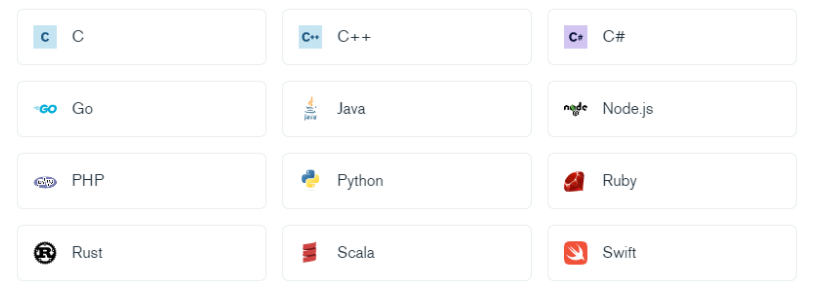玩转MongoDB—使用Go和Java客户端
【摘要】 话说上一节我们说到MongoDB的基本使用,当命令行的操作我们熟悉了以后,就可以使用相关的Driver,也就是驱动程序进行相关编程语言的使用操作,因为在实际的开发过程中总归是要用编程语言来控制的,因此这篇文章我们介绍两个最常用的编程语言—Go&Java,来使用各自的驱动链接并操作MongoDB,Start! 1 都有哪些语言有MongoDB的Driver诺,如图:你以为只有这些吗?太小看我们...
话说上一节我们说到MongoDB的基本使用,当命令行的操作我们熟悉了以后,就可以使用相关的Driver,也就是驱动程序进行相关编程语言的使用操作,因为在实际的开发过程中总归是要用编程语言来控制的,因此这篇文章我们介绍两个最常用的编程语言—Go&Java,来使用各自的驱动链接并操作MongoDB,Start!
1 都有哪些语言有MongoDB的Driver
诺,如图:

你以为只有这些吗?
太小看我们的工程师群体了,我们还有研究并开源的社区版本的Drivers,如Dart、Erlang、Kotlin等等
附上链接:https://www.mongodb.com/docs/drivers/community-supported-drivers/
2 Go连接MongoDB
2.1 添加依赖
go get go.mongodb.org/mongo-driver/mongo
2.2 代码
main函数
package main
import (
"context"
"go.mongodb.org/mongo-driver/mongo"
"go.mongodb.org/mongo-driver/mongo/options"
)
var Coll *mongo.Collection
func main() {
//URL规则:
//mongodb://[username:password@]host1[:port1][,...hostN[:portN]][/[defaultauthdb][?options]]
client, err := mongo.Connect(context.TODO(), options.Client().ApplyURI("mongodb://127.0.0.1:27017"))
if err != nil {
panic(err)
}
defer func() {
if err := client.Disconnect(context.TODO()); err != nil {
panic(err)
}
}()
Coll = client.Database("test").Collection("books")
//InsertOne()
//InsertMany()
//FindOne()
//FindAny()
//UpdateOne()
//UpdateAny()
DeleteOne()
}
具体代码:
package main
import (
"context"
"encoding/json"
"fmt"
"go.mongodb.org/mongo-driver/bson"
"go.mongodb.org/mongo-driver/mongo/options"
)
//InsertOne 添加一个
func InsertOne() {
result, err := Coll.InsertOne(
context.TODO(),
bson.D{
{"type", "计算机"},
{"name", "《MongoDB教程》"},
{"price", 9.9},
{"vendor", bson.A{"JD", "TB"}},
},
)
if err != nil {
panic(err)
}
fmt.Println(result)
}
//InsertMany 添加一批
func InsertMany() {
docs := []interface{}{
bson.D{{"type", "计算机"},
{"name", "《Go教程》"},
{"price", 19.9},
{"vendor", bson.A{"JD", "TB"}}},
bson.D{{"type", "人文"},
{"name", "《人间词话》"},
{"price", 9.9},
{"vendor", bson.A{"PDD", "TB"}}},
bson.D{{"type", "计算机"},
{"name", "《Java教程》"},
{"price", 29.9},
{"vendor", bson.A{"JD", "TB", "PDD"}}},
bson.D{{"type", "计算机"},
{"name", "《Redis教程》"},
{"price", 19.9},
{"vendor", bson.A{"JD", "TB"}}},
}
result, err := Coll.InsertMany(context.TODO(), docs)
if err != nil {
panic(err)
}
fmt.Println(result)
}
//FindOne 查找一个,多个符合条件的也返回一个
func FindOne() {
var result bson.M
err := Coll.FindOne(context.TODO(), bson.D{{"type", "计算机"}}).Decode(&result)
if err != nil {
panic(err)
}
jsonData, err := json.MarshalIndent(result, "", "")
if err != nil {
panic(err)
}
fmt.Printf("%s\n", jsonData)
}
//FindAny 查看多个
func FindAny() {
var result bson.M
//取前两条
cursor, err := Coll.Find(context.TODO(), bson.D{}, options.Find().SetLimit(2))
if err != nil {
panic(err)
}
for cursor.Next(context.TODO()) {
cursor.Decode(&result)
jsonData, err := json.MarshalIndent(result, "", "")
if err != nil {
panic(err)
}
fmt.Printf("%s\n", jsonData)
}
}
//UpdateOne 修改一个
func UpdateOne() {
result, err := Coll.UpdateOne(
context.TODO(),
//修改条件
bson.D{{"price", 9.9}},
//修改结果
bson.D{{"$set", bson.D{{"price", 39.9}}}},
)
if err != nil {
panic(err)
}
//修改文档的数量
fmt.Println(result.ModifiedCount)
}
//UpdateAny 修改符合条件的多个
func UpdateAny() {
result, err := Coll.UpdateMany(
context.TODO(),
//修改条件
bson.D{{"price", 39.9}},
//修改结果
bson.D{{"$set", bson.D{{"price", 9.99}}}},
)
if err != nil {
panic(err)
}
//修改文档的数量
fmt.Println(result.ModifiedCount)
}
//DeleteOne 删除一个
func DeleteOne() {
result, err := Coll.DeleteOne(
context.TODO(),
bson.D{{"name", "《Redis教程》"}},
)
if err != nil {
panic(err)
}
//删除文档的数量
fmt.Println(result.DeletedCount)
}
3 Java连接MongoDB
3.1 依赖
<dependency>
<groupId>org.mongodb</groupId>
<artifactId>mongodb-driver-sync</artifactId>
<version>4.6.1</version>
<exclusions>
<exclusion>
<groupId>org.mongodb</groupId>
<artifactId>mongodb-driver-core</artifactId>
</exclusion>
<exclusion>
<groupId>org.mongodb</groupId>
<artifactId>bson</artifactId>
</exclusion>
</exclusions>
</dependency>
<dependency>
<groupId>org.mongodb</groupId>
<artifactId>mongodb-driver-core</artifactId>
<version>4.6.1</version>
<exclusions>
<exclusion>
<groupId>org.mongodb</groupId>
<artifactId>bson</artifactId>
</exclusion>
</exclusions>
</dependency>
<dependency>
<groupId>org.mongodb</groupId>
<artifactId>bson</artifactId>
<version>4.6.1</version>
</dependency>
3.2 代码
package org.ymx.sb_mongodb.cache;
import com.mongodb.client.*;
import com.mongodb.client.model.Filters;
import com.mongodb.client.model.Updates;
import com.mongodb.client.result.DeleteResult;
import com.mongodb.client.result.InsertManyResult;
import com.mongodb.client.result.InsertOneResult;
import com.mongodb.client.result.UpdateResult;
import org.bson.Document;
import org.bson.conversions.Bson;
import java.util.ArrayList;
import java.util.Arrays;
import static com.mongodb.client.model.Filters.eq;
public class MongoDBUtil {
private String url = "mongodb://localhost:27017";
private MongoClient client;
private MongoCollection<Document> collection;
public void init() {
// 注意,这里我们配置mongos服务信息即可
client = MongoClients.create(url);
//获取数据库
MongoDatabase database = client.getDatabase("test");
// 获取集合
collection = database.getCollection("books");
}
public void insertOne() {
Document doc = new Document("type", "计算机")
.append("name", "《JavaScript教程》")
.append("price", 59.9)
.append("vendor", Arrays.asList("JD", "TB"));
InsertOneResult result = collection.insertOne(doc);
System.out.println(result.getInsertedId());
}
public void findOne() {
Bson eq = eq("type", "计算机");
FindIterable<Document> find = collection.find(eq);
Document first = find.first();
System.out.println(first);
}
public void insertMany() {
ArrayList<Document> documents = new ArrayList<>();
Document doc1 = new Document("type", "历史")
.append("name", "《人类简史》")
.append("price", 69.9)
.append("vendor", Arrays.asList("JD", "TB"));
Document doc2 = new Document("type", "历史")
.append("name", "《近代史》")
.append("price", 29.9)
.append("vendor", Arrays.asList("JD", "TB"));
Document doc3 = new Document("type", "计算机")
.append("name", "《Python教程》")
.append("price", 59.9)
.append("vendor", Arrays.asList("JD", "TB"));
documents.add(doc1);
documents.add(doc2);
documents.add(doc3);
InsertManyResult result = collection.insertMany(documents);
System.out.println(result.getInsertedIds());
}
public void updateOne() {
Bson bson = Filters.eq("type", "计算机");
Bson bson1 = Updates.set("type", "科学");
UpdateResult result = collection.updateOne(bson, bson1);
System.out.println(result.getModifiedCount());
}
public void findMany() {
FindIterable<Document> documents = collection.find();
documents.forEach(document -> {
System.out.println(document);
});
}
public void deleteOne() {
DeleteResult result = collection.deleteOne(eq("name", "《MongoDB教程》"));
System.out.println(result.getDeletedCount());
}
public static void main(String[] args) {
MongoDBUtil util = new MongoDBUtil();
util.init();
//util.insertOne();
//util.findOne();
//util.insertMany();
//util.updateOne();
//util.findMany();
//util.deleteOne();
}
}
4 总结
本篇文章仅展示了不同的编程语言连接MongoDB中最常用的操作,当然MongoDB的可用操作不止这些,大家还可以利用官方文档进行深入的研究。
参考:
【声明】本内容来自华为云开发者社区博主,不代表华为云及华为云开发者社区的观点和立场。转载时必须标注文章的来源(华为云社区)、文章链接、文章作者等基本信息,否则作者和本社区有权追究责任。如果您发现本社区中有涉嫌抄袭的内容,欢迎发送邮件进行举报,并提供相关证据,一经查实,本社区将立刻删除涉嫌侵权内容,举报邮箱:
cloudbbs@huaweicloud.com
- 点赞
- 收藏
- 关注作者


评论(0)